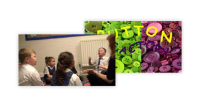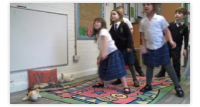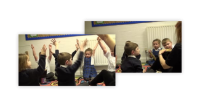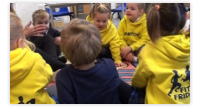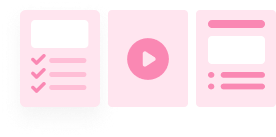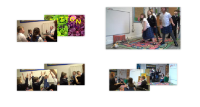Ourselves & Our Friends Level: Key Stage 1 - Creative music
Music Lesson Description
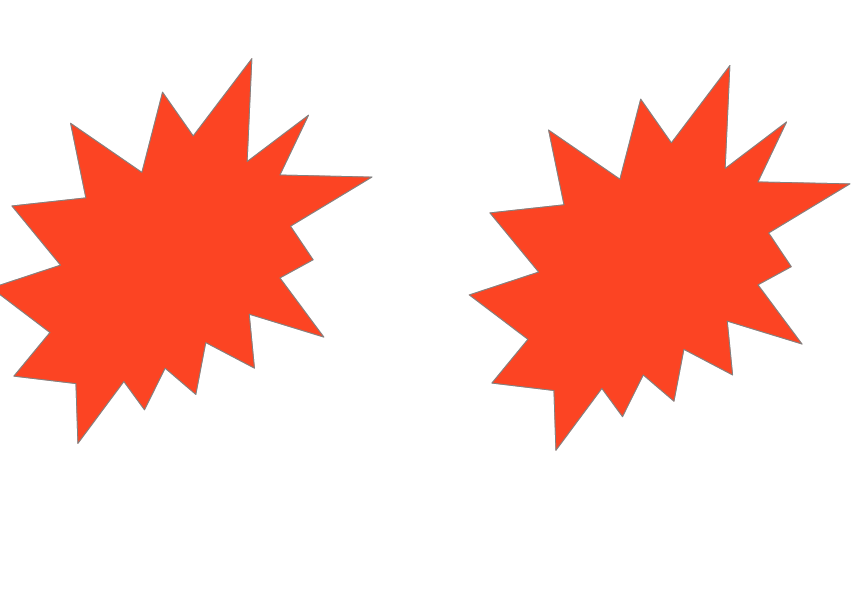
Friends' Name Clapping Cards (rhythm, pulse, structure)
Clap a Name (rhythm)
Beforehand, print out the Name Clapping Cards. First, practise - the teacher sing-songs and claps any child's name, then holds up the corresponding card with the right number of shapes while the children copy the clapped rhythm. (eg Sa-cha has two shapes, Jay has one).
If you have printed out a set of cards for each child, the next game is for you to clap the rhythm and for children to hold up the card they think goes with it. An alternative, should you be in circumstances where it is safe to do so, is to put one card in each corner of the room - the children go from corner to corner as you tap each name pattern on a drum.
Name music (pulse, structure, tempo)
You need a big space for this activity, such as a school hall. With the children divided into small groups, put a set of Name Clapping Cards out for each group, in a line, in any order. The children make up body percussion (actions-with-a-sound) to go with the number of shapes (Jump once for one, stamp twice for two, and so on). Repeat the pattern with a steady flow of sound, then try it quicker, then try slower.
Instrument Name Cards (rhythm, timbre, structure)
I like to have interesting instruments if possible, such as the World Rhythm Pack made by Percussion Plus. You need an untuned percussion instrument for every child so, if you don't have enough, home-made ones are fine, such as claves (which are actually just pieces of wood to hit together!). First explore the instrument names with the children, identifying those that have the same rhythm eg drum and claves (one syllable), chime bar and wood block (two syllables), tam-bou-rine and tri-an-gle (three syllables).
Now the children, in their groups, use instruments instead of body percussion. Each child plays their instrument in the order in which you put the cards. You will need a way of keeping the playing steady; it will sound much better if you say the words and keep a steady pulse yourself, on a drum. This is possible example of what a group of four might play first:
- claves = 1 sound
- chime bar = 2 sounds
- tam-bou-rine = 3 sounds
- fin-ger cym-bals = 4 sounds
Then you can mix up the order of the cards. The children might play this instead and you can ask them which order they preferred:
- chime bar = 2 sounds
- tam-bou-rine = 3 sounds
- fin-ger cym-bals = 4 sounds
- claves = 1 sound
Two Bits of Advice for Using Instruments!
Minimise Sound levels
Establish sensible sound levels - a whole class of children playing instruments can reach a decibel level loud enough to cause hearing damage. Have groups of children working either at different times or as far apart as the room allows - distance mimimises the effect of noise levels so use the school hall, if possible, for group instrumental work within a whole class situation.
Put It All Away
Always allow time for the children to tidy up. This can be fun if you teach a little tidying-up song. In this video I see that not everyone is singing to begin with - it was the first time the children had used these instruments and they were more fascinated by them than by the song - but they are still listening and learning, which is clear from the many times we subsequently used the put-it-all-away song.
Time to Tidy Up!
The children taught me the song they already knew about tidying up! The tune is catchy but actually it's quite a difficult one for children to pitch accurately so, if you choose this one, you'll need to spend a bit of time teaching it a line at a time using First Me, Then You. I made a recording (below the video) to help you to learn it.
